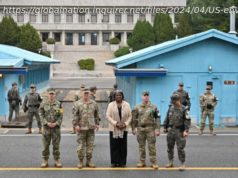What it’s like to be in the cross-hairs of the war of words between Washington and Pyongyang
In the hours following North Korea’s announcement Tuesday night that it was reviewing plans to launch ballistic missiles at Guam, a question kept coming up: “What is Guam?” Handy primers and tweet threads starting cropping up to explain. (In short: It’s a tiny U. S. territory nearly 4,000 miles west of Hawaii that’s home to two large American military bases, which are key to U. S. defense interests in the Asia-Pacific region. Most of the island’s 163,000 residents, who include indigenous Chamorros, are U. S. citizens by birth.)
Why North Korea Is Threatening Guam
Pyongyang’s statement came Wednesday morning local time, when my own family in Guam started lighting up our group chat. (Much of my family, including my dad, lives there—I lived there off and on until graduating high school.) They posted news reports, a video of Governor Eddie Calvo addressing the island’s residents, and advisories from Guam Homeland Security. They shared topical memes and wry jokes (Everyone needs to move to the mainland, my cousin who lives in Phoenix wrote.)
My dad’s sister posted a photo of the Terminal High Altitude Area Defense (THAAD) missile system, which is meant to counter regional missile attacks and was installed permanently on the island in 2013, the first time North Korea specifically named Guam as a target. (At the time, the country couldn’ t yet deliver a missile all the way to Guam; now it can, in as little as 14 minutes .)
Another cousin posted a photo of a Fox News graphic suggesting that only 3,831 Americans would be affected by a North Korean attack on Guam. “Wonder who they’ re counting, ” she wrote, adding an eye-roll emoji. She said she tried to explain to her 6-year-old brother what was going on—that a country nearby wanted to blow up the island. “Awww, but where are we gonna live?” he asked.
In the days following North Korea’s initial statement, I heard from dozens of people on island—relatives, acquaintances, strangers—who were handling things similarly. Nearly everyone expressed some level of concern about the change in rhetoric by both North Korea and the White House, but no one seemed to be suddenly alarmed; virtually everyone said they were going about their business as usual, albeit with a closer eye on the news. Some compared North Korea’s words to more “saber rattling” and likened Kim Jong Un to a “child.” A lot of new memes had begun popping up—bits of timely, locally flavored humor making fun of Kim or island culture, helping to inject some levity into residents’ daily lives.
* * *
Conflict and militarization in fact play an important role in the island’s history and identity—as well as its relationship to the United States. My colleague Krishnadev Calamur has summarized the early days of this relationship:
The island’s link to the U. S. was cemented after the Spanish-American War of 1898, when it was transferred to the control of the U. S. Navy. It remained a possession of the U. S. until December 1941 when the Japanese invaded and occupied it two days after the attack on Pearl Harbor. The Japanese occupation was brutal—about 1,000 people were killed—and lasted nearly three years. In 1944, the U. S. recaptured the island in a bloody battle against the Japanese.
The island has been a U. S. territory since then. Threats against it—this time by North Korea—could force the U. S. to revisit that bloody history.
And yet it’s precisely the U. S. military that’s now the key source of reassurance among the island residents I spoke to. “Nobody I know has panicked, ” said Amanda Gima, a 31-year-old financial adviser, who said she’s “fairly confident” in the U. S. ability to protect Guam. “I think people are worried to a certain extent, but besides packing up and leaving the island, we have to rely on the military to keep the threat at bay.”
I heard several different versions of this sentiment. “The military” isn’ t an abstraction for the island’s residents: It takes up more than a quarter of the island, including Andersen Air Force Base and the Naval Base; a controversial planned military buildup would bring thousands more American troops from Okinawa to the island in the next decade. At the same time, a large number of people from Guam join the military—residents serve at a rate three times higher than any other U. S. state, and there are thousands of Guamanians serving in the U. S. military worldwide—meaning that most locals know several current or former service members, or have served themselves.
Many civilians say that reassurances from friends and family in the military have helped them stay calm. One resident, Kathy Diaz, who has four sons who are Army officers, told the local newspaper Pacific Daily News, “I hear about (the threat) , but I’ m not worried. Only because I have boys in the military. They said, ‘Don’ t worry Mom, if anything happens, we’ ll let you know.’ I have faith in the military.”
It’s a perspective I even found myself clinging to in the hours after North Korea’s initial announcement while I absorbed the news from Washington. The first thing I did was call my dad, a retired Army colonel from Guam who served in Desert Storm. He sounded unfazed when he picked up; he insisted he wasn’ t worried and that I shouldn’ t be either, because the military was doing its job. Many others also cited either their own service or the service of relatives and friends (usually fathers, sons, siblings) , as reasons for their relative peace of mind. On Guam, “I trust the military” so often translates to, “I trust my family, my friends, my island.”
Carl Peterson, a certified financial planner who has lived on Guam for 52 years and who served in the Navy for five years, told me in an email that he had faith in both Trump’s leadership and the U. S. military. “Guamanians are always known for taking war and freedom very seriously, ” he said. (John Oliver hailed the Guamanian sense of patriotism in a Last Week Tonight segment on island voting rights in 2015: “The American flag should really just be a guy from Guam waving an American flag.”)
“The people are extraordinarily patriotic American citizens who live in a very contentious part of the world where the threats from North Korea are concerning, ” Adam Carbullido, the communications director for the Guam Congresswoman Madeleine Z. Bordallo, told me. “At the same time, we understand the role that we play as members of the American family. We hope that these events help bring light to some of the challenges that we have being a territory of the U. S. and not being fully incorporated members of the United States.”
* * *
Complicating this longstanding attitude of patriotism is the fact that Guam is a U. S. territory whose citizens cannot vote for president; it is also technically a U. S. colony (one of the last remaining colonies in the world, according to the United Nations, since unlike some other U. S. territories it’s not legally self-governing) . Guam residents often feel the island gets overlooked by mainland Americans—a sense reinforced recently by the national media’s sudden interest in the island following Pyongyang’s threats.
The inaccurate Fox News graphic I mentioned earlier, in particular, is being widely circulated on-island and has stoked anger among residents of various political backgrounds. Many told me they see it as further evidence of how ignorant the “mainstream media” is about Guam (despite the fact that top outlets are generally not under-reporting the number of Americans that would be affected by an attack on the island.)
And like anyplace else in the U. S., Guam’s residents have differing ideas about how to respond to North Korea. Some, like 26-year-old Devend Sablan, said they feel President Trump could have taken a “much softer approach” to North Korea’s threats, “rather than antagonize the enemy with fighting words.” Congresswoman Bordallo’s office, too, criticized Trump’s “fire and fury” line toward North Korea this week—a line he said on Thursday perhaps wasn’ t tough enough. “Back in 2013, President Obama had a very level response to dealing with the regime and making sure that we didn’ t do anything to further heighten the tensions, ” Carbullido said. “Whereas President Trump’s comments [on Tuesday] , they’ re not helpful and they only escalate things.” (He added that the reassuring words from Secretary of State Rex Tillerson, who landed in Guam for a refuel this week, were “helpful.”)
Though 72 percent of Guam’s voters picked Hillary Clinton for president in a straw poll last November, Trump has his supporters on-island, too.






